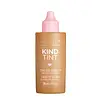What's inside
What's inside
 Key Ingredients
Key Ingredients

 Benefits
Benefits

 Concerns
Concerns

 Ingredients Side-by-side
Ingredients Side-by-side

Cyclopentasiloxane
EmollientWater
Skin ConditioningButylene Glycol
HumectantCetearyl Alcohol
EmollientTrimethylsiloxysilicate
EmollientDimethicone
EmollientPEG/PPG-18/18 Dimethicone
EmulsifyingCetyl PEG/PPG-10/1 Dimethicone
EmulsifyingPolypropylsilsesquioxane
Silica Silylate
EmollientSodium Hyaluronate
HumectantPyrus Malus Fruit Extract
Skin ConditioningCocos Nucifera Fruit Juice
EmollientCocos Nucifera Water
MaskingPotassium Sorbate
PreservativePolysorbate 20
EmulsifyingDisteardimonium Hectorite
StabilisingTribehenin
EmollientSodium Chloride
MaskingPropylene Carbonate
SolventCaprylyl Glycol
EmollientGlycerin
HumectantHexylene Glycol
EmulsifyingPhenoxyethanol
PreservativeIron Oxides
CI 77891
Cosmetic ColorantCyclopentasiloxane, Water, Butylene Glycol, Cetearyl Alcohol, Trimethylsiloxysilicate, Dimethicone, PEG/PPG-18/18 Dimethicone, Cetyl PEG/PPG-10/1 Dimethicone, Polypropylsilsesquioxane, Silica Silylate, Sodium Hyaluronate, Pyrus Malus Fruit Extract, Cocos Nucifera Fruit Juice, Cocos Nucifera Water, Potassium Sorbate, Polysorbate 20, Disteardimonium Hectorite, Tribehenin, Sodium Chloride, Propylene Carbonate, Caprylyl Glycol, Glycerin, Hexylene Glycol, Phenoxyethanol, Iron Oxides, CI 77891
Water
Skin ConditioningSqualane
EmollientCaprylic/Capric Triglyceride
MaskingStearyl Alcohol
EmollientCetyl Alcohol
EmollientHelianthus Annuus Seed Oil
EmollientCoco-Caprylate
EmollientGlyceryl Stearate
EmollientButyrospermum Parkii Butter
Skin ConditioningSodium Hyaluronate
HumectantSr-Hydrozoan Polypeptide-1
HumectantAscorbic Acid
AntioxidantCitrus Aurantium Dulcis Flower Extract
Skin ConditioningNiacinamide
SmoothingTocopherol
AntioxidantCaffeine
Skin ConditioningJasminum Officinale Flower Extract
MaskingLeuconostoc/Radish Root Ferment Filtrate
AntimicrobialXanthan Gum
EmulsifyingSodium Phytate
Lauroyl Lysine
Skin ConditioningGlycerin
HumectantCitric Acid
BufferingPropanediol
SolventPhenoxyethanol
PreservativeEthylhexylglycerin
Skin ConditioningSodium Benzoate
MaskingCI 77891
Cosmetic ColorantIron Oxides
Water, Squalane, Caprylic/Capric Triglyceride, Stearyl Alcohol, Cetyl Alcohol, Helianthus Annuus Seed Oil, Coco-Caprylate, Glyceryl Stearate, Butyrospermum Parkii Butter, Sodium Hyaluronate, Sr-Hydrozoan Polypeptide-1, Ascorbic Acid, Citrus Aurantium Dulcis Flower Extract, Niacinamide, Tocopherol, Caffeine, Jasminum Officinale Flower Extract, Leuconostoc/Radish Root Ferment Filtrate, Xanthan Gum, Sodium Phytate, Lauroyl Lysine, Glycerin, Citric Acid, Propanediol, Phenoxyethanol, Ethylhexylglycerin, Sodium Benzoate, CI 77891, Iron Oxides
Ingredients Explained
These ingredients are found in both products.
Ingredients higher up in an ingredient list are typically present in a larger amount.
Ci 77891 is a white pigment from Titanium dioxide. It is naturally found in minerals such as rutile and ilmenite.
It's main function is to add a white color to cosmetics. It can also be mixed with other colors to create different shades.
Ci 77891 is commonly found in sunscreens due to its ability to block UV rays.
Learn more about CI 77891Glycerin is already naturally found in your skin. It helps moisturize and protect your skin.
A study from 2016 found glycerin to be more effective as a humectant than AHAs and hyaluronic acid.
As a humectant, it helps the skin stay hydrated by pulling moisture to your skin. The low molecular weight of glycerin allows it to pull moisture into the deeper layers of your skin.
Hydrated skin improves your skin barrier; Your skin barrier helps protect against irritants and bacteria.
Glycerin has also been found to have antimicrobial and antiviral properties. Due to these properties, glycerin is often used in wound and burn treatments.
In cosmetics, glycerin is usually derived from plants such as soybean or palm. However, it can also be sourced from animals, such as tallow or animal fat.
This ingredient is organic, colorless, odorless, and non-toxic.
Glycerin is the name for this ingredient in American English. British English uses Glycerol/Glycerine.
Learn more about GlycerinPhenoxyethanol is a preservative that has germicide, antimicrobial, and aromatic properties. Studies show that phenoxyethanol can prevent microbial growth. By itself, it has a scent that is similar to that of a rose.
It's often used in formulations along with Caprylyl Glycol to preserve the shelf life of products.
Sodium Hyaluronate is hyaluronic acid's salt form. It is commonly derived from the sodium salt of hyaluronic acid.
Like hyaluronic acid, it is great at holding water and acts as a humectant. This makes it a great skin hydrating ingredient.
Sodium Hyaluronate is naturally occurring in our bodies and is mostly found in eye fluid and joints.
These are some other common types of Hyaluronic Acid:
Learn more about Sodium HyaluronateWater. It's the most common cosmetic ingredient of all. You'll usually see it at the top of ingredient lists, meaning that it makes up the largest part of the product.
So why is it so popular? Water most often acts as a solvent - this means that it helps dissolve other ingredients into the formulation.
You'll also recognize water as that liquid we all need to stay alive. If you see this, drink a glass of water. Stay hydrated!
Learn more about WaterThis ingredient is a combination of red, black, and yellow iron oxide pigments. This combination of colors is usually found in foundation, because it results in a "skin" color.